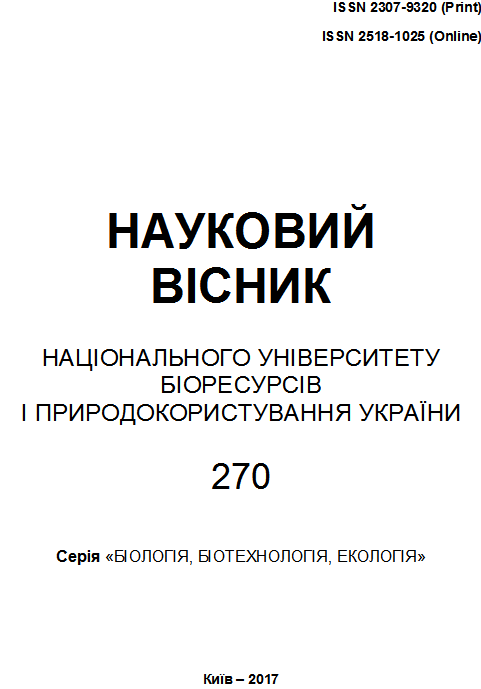STAPHYLOCOCCUS AUREUS AND FUNGI OF GENUS CANDIDA SENSITIVITY TO ADAMANTYL-BASED DERIVATIVES OF AMINOPROPANOL-2
Abstract
The aim of the study was to determine the sensitivity of the museum and clinical strains of staphylococci and fungi of the genus Candida to 27 new adamantylbased derivatives of aminopropanol-2. An antibacterial and antimycotic action of the substances was evaluated according to the minimum inhibitory concentration (MIC) and to the minimum bactericidal or fungicidal concentrations (MBcC or MFcC), which were determined by the micro-method of sequential serial dilutions in a liquid nutrient medium. A museum strain and 10 clinical isolates of Staphylococcus aureus, as well as 5 museum strains and 6 clinical isolates of fungi of the genus Candida are used in the study. As a result of the studies, the significant antimycotic properties in compounds №№1, 6, 10, and 23 were revealed. The MIC of these substances in relation to the museum strains and clinical isolates of Candida species were in the range from 7.8μg/ml to 62.5μg/ml. Substances №6 and №10 showed a moderate effect on staphylococci also. The MIC of compounds, highly active against museum test strains of microorganisms in most cases were equal to the value of the MIC of these substances for clinical isolates of staphylococci and fungi of the genus Candida. Analysis of the antimicrobial activity of substances depending on their chemical structure allowed to put forward a number of assumptions about the influence of some radicals on the presence of antimicrobial properties in the investigated substances.
References
Michael, C. A., Michael, C. A., Dominey-Howes, D., Labbate, M. (2014). The antimicrobial resistance crisis: causes, consequences, and management. Front Public Health, 2, 145. doi: 10.3389/fpubh.2014.00145. e
Glumcher F. S., Dubrov S. A., Kuchin Yu. L. (2014). Plyrezistentnaja infekcija: aktualnost, opredelenue, mehanizmi, naibolee rasprostranjennie patogeni, ktchenie, profilaktika [Multiresistance infection: relevance, definition, mechanisms, most common pathogens, treatment, prevention]. Science and practice, 1 (2),129 – 149.
Lamoureux, G., Artavia, G. (2010). Use of the adamantane structure in medicinal chemistry. Curr. Med. Chem., 17, 2967–2978. doi:10.2174/092986710792065027
Grillaud, M., Bianco, A. Multifunctional adamantane derivatives as new scaffolds for the multipresentation of bioactive peptides (2015). J. Pept. Sci, 21(5), 330–345. doi: 10.1002/psc.2719.e
Liu, J., Obando, D., Liao, V., Lifa, T., Codd, R. (2011). The many faces of the adamantyl group in drug design. European Journal of Medicinal Chemistry, 46, 1949-1963. doi: 10.1016/j.ejmech.2011.01.047.e
Wanka, L., Iqbal, K., Schreiner, P.R. (2013). The lipophilic bullet hits the targets: medicinal chemistry of adamantane derivatives. Chem. Rev., 113, P. 3516–3604. doi: 10.1021/cr100264t.e
Bagrij E. I. (1989). Adamantani: poluchenie, svojstva, primenenie [Adamantanes: Getting, Properties, Application]. Moscow, Russia: Science, 264.
Balzarini, J., Pannecouque, C., De Clercq, E., Pavlov, A.Y., Printsevskaya, S.S., Miroshnikova, O.V., Reznikova, M.I., Preobrazhenskaya, M. N. (2003). Antiretroviral activity of semisynthetic derivatives of glycopeptide antibiotics. J. Med. Chem., 46, N (13), 2755-2764.doi:10.1021/jm0300882.e
Korotkij Yu. V., Vrinchanu N. A., Maximov Yu. N., Lozickij M. O. (2011). Sintez, antimikrobnaja i protivogribkovaja aktivnost chetvertichnih solej adamantancoderzashchih alkoksidialkil aminopropanolov [Synthesis, antimicrobial and antifungal activity of quaternary salts of adamantane-containing alkoxydialkyl aminopropanols] Chem. Pharm. Journal, 1(45), 21-23.
Wang, J. J., Wang, S.S., Lee, C.F., Chung, M.A., Chern, Y.T. (1997). In vitro antitumor and antimicrobial activities of N-substituents of mabeimide by adamantine and diamantine. J. Chemother., 43 (3),182-189.
Vrinchanu N. A., Pokas E. V., Maximov Yu. N. (2003). Antifungalnoe dejstvie 4-adamantil-1-(1-aminobutil) benzola v otnoshenii klinicheskih shtammov gribov [Antifungal action of 4-adamantyl-1- (1-aminobutyl) benzene in relation to clinical fungi strains]. J. Infection Pathology, 10 (4), 33-34.
Korotkij Yu. V., Vrinchanu N. A., Dronova M. L., Suvorova Z. S., Smertenko O.A. (2015). Sintez, antibakterialna ta antifungalna aktivnist pohidnih 1|4 (1,1,3,3, tetrametilbutil) fenozi|3 dialkilamino 2 propanolu [Synthesis, antibacterial and antifungal activity of derivatives 1|4 (1,1,3,3, tetramethylbutyl) phenoxy|3-dialkylamino-2-propanol]. Pharm. J., 1, 56-62.
Voljanskij Yu. L., Gricenko I. S., Shirobokov V. P., Dubinina N. V., et al. (2004). Vivchennja specifichnoi aktivnosti protimikrobnich likarskih zasobiv [Study of specific activity of antimicrobial drugs] Metodical recomendations. Kiev, 38.
Voloshchuk O. M., Korotkij Yu. V., Shirobokov V. P., Smertenko O.A. (2014). Antimikrobnie svojstva novih sintezirovannih soedinenij oxiaminiproizvodnih alociclicheskih i nasishennih geterociklicheskih kondensirovannih sistem [Antimicrobial properties of new synthesized compounds of oxyamine derivatives of alicyclic and saturated heterocyclic condensed systems]. Collection of materials of the international scientific conference. Modern studies of medical and biological sciences. (Электронный ресурс). Moscow (Russia), 87-95.
Downloads
Published
Issue
Section
License
Relationship between right holders and users shall be governed by the terms of the license Creative Commons Attribution – non-commercial – Distribution On Same Conditions 4.0 international (CC BY-NC-SA 4.0):https://creativecommons.org/licenses/by-nc-sa/4.0/deed.uk
Authors who publish with this journal agree to the following terms:
- Authors retain copyright and grant the journal right of first publication with the work simultaneously licensed under a Creative Commons Attribution License that allows others to share the work with an acknowledgement of the work's authorship and initial publication in this journal.
- Authors are able to enter into separate, additional contractual arrangements for the non-exclusive distribution of the journal's published version of the work (e.g., post it to an institutional repository or publish it in a book), with an acknowledgement of its initial publication in this journal.
- Authors are permitted and encouraged to post their work online (e.g., in institutional repositories or on their website) prior to and during the submission process, as it can lead to productive exchanges, as well as earlier and greater citation of published work (See The Effect of Open Access).

